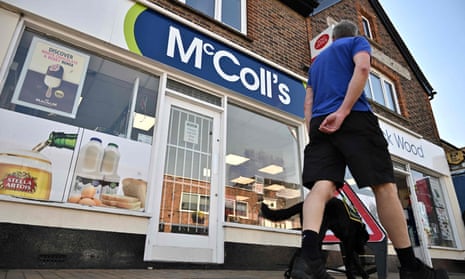All’s well that ends well? Not quite. McColl’s has obviously got the right rescuer in the shape of Morrisons, the biggest supplier by far to the 1,100-strong convenience store chain. But David Potts, the chief executive of Morrisons, was entitled to say he was “disappointed” that this mini-drama involved McColl’s going into administration at all. He could have said “furious”.
His group’s proposal at the end of last week to take the business in solvent form appeared to tick the main boxes. It protected pensioners, sought to maximise employment among McColl’s 16,000 staff and allowed bank lenders to switch into Morrisons-backed debt with a superior covenant. Most of all, the plan had commercial sense in its favour: with 250 McColl’s stores trading under the Morrisons Daily banner, so the major supermarket had a strong incentive to make the mismanaged operator work. It has looked the natural owner of McColl’s for weeks, if not months.
So why were administrators summoned by the banks last Friday? The answer to that question seems only to be the fact that the rival proposal from EG Group, the petrol forecourt business owned by the Issa brothers of Asda fame, would have seen lenders get paid in full upfront. Put another way, the banks – understood to include Barclays, HSBC and NatWest – prioritised certainty for themselves even though the EG proposal, at that stage, created uncertainties for McColl’s pensioners who were exposed to the risk of a cut in their benefits.
As it happens, Morrisons succeeded over the weekend by matching EG’s offer to the banks (and EG, incidentally, improved its pitch to pensioners by saying it would have accepted full responsibility for the two pension funds). But the sour taste left by this saga is that the banks put the business into administration, thereby creating extra risks. There was no need to do so. These situations are often messy and rushed, but this one did not have to be.
No harm was ultimately done this time, but Kwasi Kwarteng, the business secretary, should take note. A recession looms and UK plc will need its lenders to see the wider picture in many more rescue jobs.
Time for Sunak to ditch ‘wait and see’ line on energy bills
The most irritating line in politics at the moment is the Treasury’s refrain that the chancellor will take a view on further support for hard-pressed energy consumers only after Ofgem announces in August the next change in its price cap, which will apply from the start of October.
It is irritating, first, because it seems to imagine that miraculous news on energy prices could turn up between now and August. The reality is that, even if wholesale markets provide mild relief from here, bills are going up in the autumn. The six-month “observation window” for setting the next price cap has already passed the halfway point and current projections suggest a figure close to £2,900 for an average household, versus £1,971 today.
And it is irritating, second, for a reason highlighted by comments from Keith Anderson, the chief executive of Scottish Power, on Monday. “You need to be in a position to name a solution in July if there’s going to be time to devise a method of implementing it in time for October,” he said. Well, quite. If support is to be administered through bills, which would be the most direct method, systems have to be reset and qualifying criteria have to be agreed. The process can be fiddly. A last-minute scramble risks a package that is full of holes.
Anderson’s preferred solution is well known: a £1,000 reduction off bills for low-income households, who could be defined in a number of ways – via universal credit or the warm homes discounts scheme, or more of a challenge, via a definition of fuel poverty. The proposal has its pluses and minuses but it does, at least, recognise the scale of what’s needed: last winter the price cap was £1,277, so an increase to £2,900-ish would take energy bills into unaffordable territory for millions of households. Rishi Sunak’s modest February package is not big enough to cope.
It is possible that Treasury cogs are whirring behind in the background, but nothing we have heard from Sunak suggests so. Yes, the precise level of the price cap matters, but there is still a big planning and modelling job to be done. The Treasury could do everybody a favour by dropping its “wait and see” chant and recognising the urgency of developing a plan for a crisis that could yet become worse.

